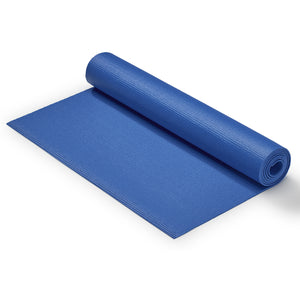How to Meditate: The What’s, How’s, and Why’s
There’s never been more discussion around how to meditate. Whether for Instagram influencers, grade-school children, senior citizens, folks working on their mental health, or literally anyone, “Meditate!” is quickly becoming the new “Hydrate!”
In this article, you’ll learn about meditation, how to meditate, and its many benefits to your life.
What Meditation Is
While there are many philosophies of meditation and many ways to meditate, meditation generally involves the conscious practice of achieving a state of calm or relaxation for the purpose of enhancing health and well-being, whether physical and/or mental, outside of the time spent meditating. In this way, this seemingly passive activity of sitting quietly can benefit the rest of your life.
There are two main types of meditation: outcome-oriented and process-oriented. Although the biased proponents of one may cast aspersions on the other, the truth is that either type can work for you.
Outcome-oriented meditation styles are the more popular of the two in Western society. They emphasize the achievement of mental calm during the meditation itself. These meditation styles tend to involve ignoring, escaping, or suppressing one’s conscious thoughts using strong mental imagery (imagining yourself on a mountaintop or quiet garden), intense focus on breathing, counting, or a mantra, or attempting to empty one’s mind of thoughts.
Process-oriented meditation styles view the process of meditation as a means to an end outside of meditation itself. Instead of suppressing or controlling one’s thoughts, the mind is allowed to wander freely without judgment. Certain thoughts and feelings that may create anxiety in the conscious mind can rise to the top and be accepted without judgment by the meditator, hence reducing the anxious feelings surrounding them. Sometimes a meditation sound is employed, but the meditator does not cling harshly to the sound to avoid their thoughts; rather, the thoughts are allowed to coexist with the sound, and by extension, with the meditator.
To employ a simile, outcome-oriented meditation is like taking a vacation while process-oriented meditation is like going to a therapy session.
With either type, the hope is that these practices will result in more calm throughout the day, leading to less anxiety, an easier time dealing with adversity, and ultimately the development of one’s personality.
Meditation Guide: 4 Ways to Meditate
I’ve selected 2 outcome-oriented styles and 2 process-oriented meditation styles.
Outcome-Oriented Style One: Singular Focus
Problems with focus are extremely common in everyday life. People find themselves scrolling endlessly on their phones when they’re supposed to be working, fiddling with their phones while driving, or looking at their phones every five minutes while trying to watch a movie.
See a pattern? Smartphones have effectively trained our brains to be distracted. Ideally, we would just get rid of them (the phones, not our brains!), but many people rely on their phones for too many things, making this impractical. A meditation that involves focusing on one thing (what I call Singular Focus) can, in theory, train your brain to focus better.
To practice Singular Focus meditation, try this: set a timer for ten minutes. Sit in a chair, close your eyes, and focus on your breathing: in through the nose and out through the mouth, nice and steady. Do not let other thoughts distract you from your breathing. If they do, just come back to it. An alternative version would be to light a candle, set a timer, and focus on the candlelight and nothing else until the timer runs out.
Outcome-Oriented Style Two: Mindfulness Exercises
Here’s a question: what do you think about when you brush your teeth? Have you ever just focused on brushing your teeth while brushing them? Give it a try right now. We’ll wait.
It’s harder than it seems. This is because the mind is trained to focus on things other than the here and now: “what am I going to make for dinner tonight?” “When is that project due?” “That bully in sixth grade was a real jerk.” “I can’t believe I blurted that out during the meeting.” “I should get an air fryer.” These thoughts crowd in, and your emotional state reacts to them, with anxiety, worry, resentment, regret, longing, or any number of other feelings.
Mindfulness involves being “mindful” of what you’re doing and not letting any other thoughts encroach on that thought process. Therefore, it can be practiced sitting in a chair like any other meditation, or at pretty much any point in everyday life.
For starters, sit somewhere that is relatively quiet. Let’s say you’re on a park bench. Close your eyes and say to yourself, “I’m sitting here quietly, in this park, feeling the gentle breeze, hearing the birds sing, breathing softly in and out.” Use whatever details apply to your situation.
By doing this, you are choosing to exist in “the here and now,” getting away from those constant thoughts and their related emotional reactions, for at least a while.
Process-Oriented Style One: The Free Mental Attitude
The concept of the Free Mental Attitude comes from the Scandinavian school of meditation called Acem (pronounced OCK-um). Having a free mental attitude means that, although you use a meditation sound, you don’t cling to it harshly in order to suppress the thoughts of your wandering mind. Instead, you repeat the sound softly and effortlessly, and let the thoughts flow freely without judgment.
Only a qualified instructor can teach true Acem practice, but here’s something similar: sit in a comfortable chair with your back supported. Set a timer for at least ten minutes. Close your eyes, relax your body, and start repeating a meditation sound over and over again in your mind (not out loud).
What sound should you use? Select three syllables: “Bo-tah-say,” “nee-mah-sah,” “she-gah-tay,” or something along those lines. The syllables should not mean anything to you. Even though you’ll repeat them in your mind, they should “roll off the tongue” easily.
If you “lose” the sound, calmly start it back up again. If you need to move your body, move it. Don’t worry about “am I doing it right?” Don’t worry about how you’re breathing. Just repeat the sound and let the thoughts flow.
Process-Oriented Style Two: Free-writing
Free writing is not the same as journaling. You’re not recording your thoughts; you’re letting them out without judgment. No one else is going to read what you write; you probably won’t even read it. You don’t judge the thoughts or feelings being set down on the page; you don’t judge the handwriting, sentence structure, layout, or if the writing stays inside the lines. You just let whatever is inside of you come out.
To try freewriting in this way, simply set a timer, sit down at a table with your pen and paper (a legal pad is perfect) or computer, and start writing. If you use a computer, make sure to silence notifications and other aspects of computers that can distract you.
Start with five minutes. You might find that you have a clearer mind for the rest of the day. You might even discover issues or problems that you weren’t fully aware of that you can now address.
Which Type Should I Select?
Everyone is different. Do you think of yourself as an overthinker? Outcome-oriented might be better for you because it can train you to control your thoughts. At the same time, your racing thoughts may be caused by anxiety about what lies beneath those thoughts, hence process-oriented might work better.
But speaking of anxiety, if you find yourself in a panicky moment, process-oriented meditation like mindfulness can be helpful because it pulls your attention away from panic-inducing thoughts.
So, it really depends on the person. The thing with outcome-oriented, though, is that it is an investment: although the meditation itself might be relaxing (and it should be), the larger-scale outcomes take a while to reveal themselves. So, if you try it, stick to it for a while, at least a month, preferably more. As with so many things, consistency is key.
Benefits
The benefits of meditation are well-documented. Relaxation, a clearer mind, and less general anxiety are the most common, while improved sleep, higher happiness levels, and an easier time focusing are also reported. In some cases, especially with long-term consistency, meditation can lead to a better sense of oneself, a closer connection to one’s feelings, and a resulting increase in creativity and fewer feelings of being blocked, stuck, or empty.
Conclusion
With luck, this article reached you at a time when your mind is open to meditation. Maybe it inspired you to try one or two things to reap meditation's benefits, and the best part is, you don’t need expensive potted plants, candles, beads, bells, bowls, fountains, or incense sticks to meditate. All you need is a quiet place to sit and the courage to believe that peace is not in the future or the past, in some purchase or in some great undertaking, but within you.
David Gelles. https://www.nytimes.com/guides/well/how-to-meditate
Are Holen & Halvor Eifring.Acem Meditation: An Introductory Companion. Acem Publishing, Oslo. 2007. Accessed 18 November 2022.
Are Holen. Inner Strength, 2nd Revised Edition. Acem Publishing, Oslo. 2000-2007. Accessed 18 November 2022.
Maharishi Mahesh Yogi. Science of Being and Art of Living: Transcendental Meditation. Penguin, New York. 1995. Accessed 18 November 2022.
Osho. Meditation. St. Martin’s Griffin, New York. 2004. Accessed 18 November 2022.

Mark Ludas CPT is a NASM-certified personal trainer with a decade of experience in the fitness industry. After an asthmatic childhood, Mark discovered his natural aptitude for fitness in his late twenties. At age 36, he accomplished a 300+ pound conventional deadlift and 280+ high-bar squat as a 6’5” 170-pound ectomorph on a fully vegan diet, all after just one year of proper self-programming. Mark is the founder of Resistance Quest Fitness, established in 2016. Additionally, he is a writer, actor, model, and musician. Find him on Instagram, Facebook, Youtube, and at www.resistancequest.com.

























Add Your Name & Email
Please enter your name and email to continue.We won’t display your email publicly.